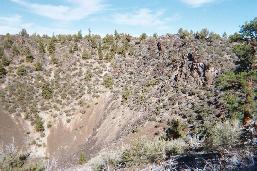

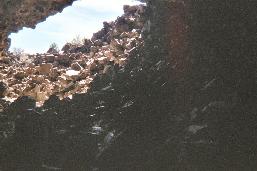
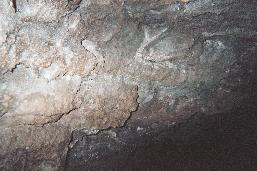

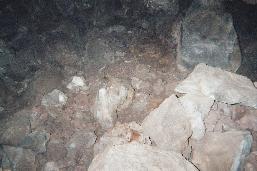
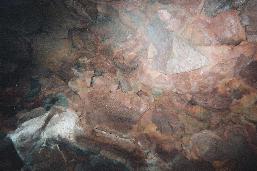
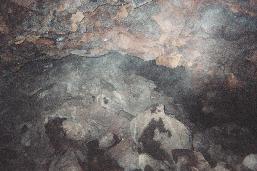
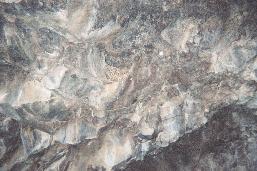
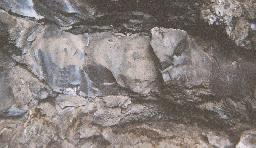
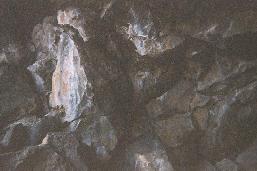

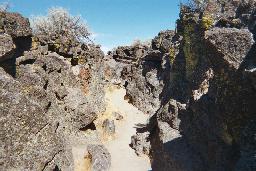
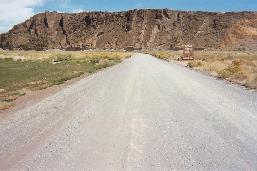
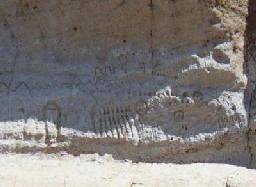
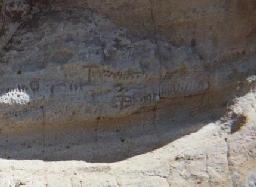
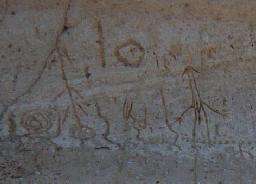
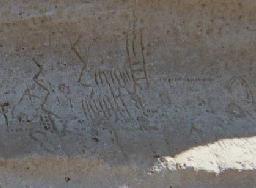

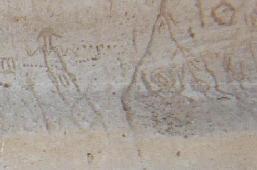
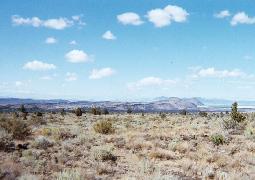
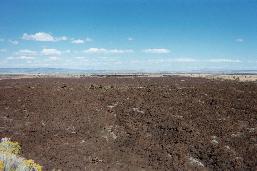
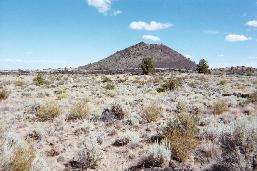
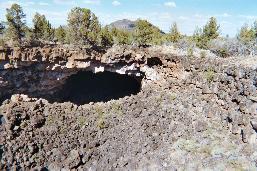
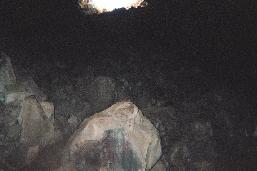
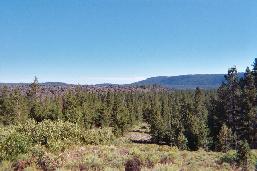
Richard's Medicine Lake Journey
Day Five, September 2, 2004
©Richard J. Gorman 2004
The allergy relents soon after I leave camp. I designate this day "monument day", intending to spend most of the day in Lava Beds National Monument. After another hearty breakfast, I drive north into it, and visit the beautiful new visitor center. After a quick look around the gift shop, I talk to the staff. By now I know what I want to see, ice caves and petroglyphs. They tell me that if I am interested in petroglyphs, I may want to check out the pictographs as well, and direct me to some of the places described below, first insisting that I carry two flashlights when caving. I buy another, bigger flashlight -- I was going to anyway. But they clearly are not going to tell me about any of the ice caves off the beaten track, as they did when I came with my brother 25 years ago, undoubtedly because I am alone.
Clicking the little picture makes the big picture open in a new window.
 |
Before I go to the visitor center, I stop for a look at Giant Crater, on the southern edge of the monument. Imagine this awesome maw brimming over with molten rock, for that is how it was formed. |
 |
Skull Cave is so-named from an 1898 discovery of a wagonload of bones that included wild and domestic animal, as well as human skeletons. I wonder by what name the ancients knew it. This is the "tourist" cave, so it has a well developed path and several flights of steel stairs leading to the ice floor. Regrettably, tourists have borne so much dust and dirt into the cave that the ice has lost its clarity, and the landing at the ice floor is a steel cage that makes it difficult to see the ice, much less photograph it. I can certainly feel it, though. |
 |
I have the cave to myself. And I have the big new flashlight, so I go explore. Because this is the "tourist" cave, the trail is well developed, and you don't have to crawl down in over the broken up rock that forms the floor of most of the caves I visit. I look back at the sky as I venture down into the darkness, and after a few twists and turns, dark it is. I am fascinated by these volcanic caves, but at a loss for words to describe them. |
 |
The rocks underground are different from those above the ground. There is a lot of colorful mineralization, and bright red mosses or lichen that grow in the dark, and there are strange shapes and colors and textures everywhere. Leaving Skull Cave I am passed by a school bus coming in. Not that I don't like kids, but I am happy I had it to myself. |
 |
Big Painted Cave is where the rangers tell me to go to see pictographs. I hike the mile plus easy trail, and find an interpretive marker that again tells me I am in a sacred place and to walk with reverence. It is a place where vision quests are undertaken, and the one- to five-thousand year old pictographs are symbolic of spiritual experiences. The power of this place is palpable in a way I cannot describe in words, but I feel a sense of heightened awareness that is beyond fear. Oh, and I forget the big new flashlight in the car, and venture in with the pocket light in hand. This portal is deep in the cave, and I decide to not go much further, even though I have found no pictographs. |
 |
Beyond the portal is this chamber where prudence dictates I stop. My flashlight is starting to weaken, and I have a white-knuckle grip on it. The flash camera helps see where I am, but it probably won't help me find my way out. I take a couple of pictures of the colorful parts of the chamber, as seen below. |
 |
Wall of chamber. |
 |
Roof of chamber. After taking these pictures, I turn off the light, and sit there trying to grok the place. There is no light. None. Eyes open or closed it is the same. There is no air movement. There is no sound save a very slow drip. I stay there for a time, feeling this place, or perhaps not feeling it. Certainly not seeing it. I wonder what kind of portable lights the ancients would have used. |
 |
On the way into the cave, at the mouth, I had seen a lot of bird shit on the path, and stopped to look for its source, but discerned nothing. Coming out I notice the bird's nest in the wall. It's there in the middle of the picture, in a niche of the rock wall, and it is composed of large twigs and sticks, two or more feet wide, at least the part I can see. At the place of the shit, I find the feather. Actually two feathers, but I decide to keep only the one. I later feel that deciding to leave the second feather behind may have been an important decision, but I am not sure why. The one I keep is twelve inches long, asymmetrical, and black. At the moment I decide it is a gift from Eagle. I put it in my hair. |
 |
In wonder, I continue to Symbol Bridge, and there the pictographs, the signs, are obvious and numerous. And again the marker tells me that this is a sacred place as well. By now I realize that I truly am on a quest of my own, if unintended. I find what I do not know I am looking for. I am present in a place where people have come for ages seeking, and finding, enlightenment. Magic is afoot here. |
 |
With the curiosity of a tourist and the heart of a pilgrim, I spend some time here wondering. Wondering what they used for paint, wondering how they got up there to to paint these symbols, wondering what it meant to them, wondering why. Wondering why they have endured for me to see. For a long time, I am deeply moved, and I experience a true transcendence. |
 |
As I walk away from this place, I realize that to walk with reverence is to walk with dignity. I realize that this is something I need to apply in a broader sense, and I realize that this is part of the lesson I was drawn here for. I continue to remember this lesson daily. |
 |
Having been introduced to Lava Beds long ago, I know it is the land of the Modocs, and their tale is as woeful as any of those of the first peoples. If you are interested in this, there are many more authoritative sources than I. Visiting Captain Jack's Stronghold, the site of the last "Indian" war in this country, I am still carrying the feelings from this morning, and I sense that the spirits of this place have not found peace. A great sadness lingers here. This is a passage within the Stronghold, which a small band of Modocs defended for six months in the winter of 1872-73, against up to a thousand US troops. |
 |
Continuing my search for petroglyphs, I return to Petroglyph Point, on the advice of the rangers. Approaching from this side, I see the face of the bluffs I was on top of yesterday. Glad I am that I did not know it then! What is the difference between a bluff and a cliff? This one has a large colony of diverse birds nesting on it: Eagle, prairie falcon, swallow, and more. At it's base, along the old lake shore, is a band of softer rock, and it is rife with rock carvings believed to be two to five thousand years old. |
 |
At the base of the cliff, the band of carvings is hundreds of yards wide, four or five feet tall, and about six feet above the ground. Numerous and varied, the interpretive brochure says they are believed to be more related to hunting and fishing than to spiritual pursuits. Still, like the henges and dolmens in the old world, they are wonders left by the ancients, and one can only guess and grasp at their meaning. It is said there are over 5000 individual carvings here. I will let the rest of the pictures speak for themselves. What do you think they mean? |
 |
Petroglyph Point, Lava Beds National Monument, September 2004 |
 |
Petroglyph Point, Lava Beds National Monument, September 2004 |
 |
Petroglyph Point, Lava Beds National Monument, September 2004 |
 |
Petroglyph Point, Lava Beds National Monument, September 2004 |
 |
Petroglyph Point, Lava Beds National Monument, September 2004 |
 |
After Petroglyph Point, reality intrudes upon my day. On the advice of the rangers, I hit the highway north to Merrill, Oregon to buy gas. They actually pump your gas for you in Oregon! And I stop in Tulelake on the way back, in search of block ice, another camera, and lantern mantles (but that's another story). Finding all of these, I drive west across the top of Tulelake, and come back into the monument along the west side, at the foot of those bluffs in the picture. Tulelake itself is a reason to go back, another story. This may be my favorite picture of the tour. |
 |
I've got a new camera, so I stop and take pictures along the road back to camp. Devil's Homestead is another lava flow that originates at a place called Fleener Chimneys, a place I'll visit next time, another pimple on the flanks of Medicine Mountain. The lava flow is three or four miles long and at least a mile wide in places. It is old enough that there are plant colonies establishing on it, hardy plants that can thrive on the barest of soils. |
 |
I can't leave Lava Beds without a picture of Schonchin Butte. At 5341', it is the dominant feature here, and there is a trail to the lookout at the top. I haven't hiked that, I haven't found the pictographs in Big Painted Cave, I haven't found that one ice cave, I haven't spent enough time at Tulelake watching the birds. So while I leave Lava Beds with regret that I haven't enough time, I have collected several excuses to go back. |
 |
And, I can't resist taking another hike when I see the sign that says Heppe Ice Cave. Someone has been riding a bike on this trail! While it is totally illegal to ride here, I wish I had not left mine back in camp. That is, until the trail abruptly comes to this edge of the cave mouth, where failure to stop in time could be fatal. The side I'm standing on looks just like what I'm looking at, overhang and all. |
 |
This cave has two openings, places where the lava tube collapsed, leaving this large chamber in between. Only one opening is accessible by the trail, and from the bottom, I take a picture of the other opening. Mineralization on the roof of the cave caused by seepage can be seen in another photo here. There is no ice in this cave, just a puddle in the bottom, that until I get really close, looks like a passage to another place. |
 |
Driving back to camp, I find a good vantage point for a look at Medicine Lake Lava Flow, with its abrupt edge, and the lake itself can be seen on the right. |
Back at camp, further research reveals that the nest and the feather from this morning may just as well be Raven's, a symbolic bird none the less. But I have little time for research and reflection, as I have arrived at camp late in the day. The allergy kicks back into full gear again, and the wind in the treetops is beginning to sing. I make a hasty dinner, and eat it in the car because it is getting cold. After dinner, a fire keeps me warm for a while, but the wind continues to rise until it is literally howling overhead. It is as if the spirit of the lake has decided to vocalize. I wake often in the night.